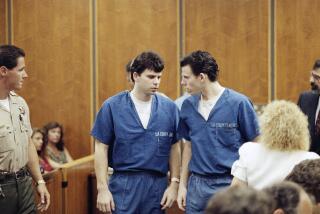Wedding Bells Often Heard Behind Bars
If people cry at a wedding âup the river,â their tears might represent more than joy: The decor is probably a cinder-block visitorsâ area, the attire for the incarcerated spouse-to-be could well be an orange jumpsuit, and for many couples, it is their first opportunity to hold hands--with or without handcuffs.
Because he did not want to be married by his sentencing judge, Lyle Menendez might have to take his vows in a setting less distinguished than a California courtroom. Before dawn Wednesday, a bus carried Lyle Menendez, and his brother Erik, from the Menâs Central Jail in downtown Los Angeles to North Kern State Prison in Delano, a Sheriffâs Department spokeswoman said.
But Lyle will hardly be the first convict to become part of a couple while in prison, if he is successful in his bid to wed.
Although neither the state Department of Corrections nor the County Jail keeps a tally on the number of inmates who marry behind bars, prison chaplains, judges and jail volunteers say there is no shortage of brides-to-be--especially those interested in hooking up with the more infamous prisoners.
Male inmates marry far more frequently than female prisoners. Desperate for a committed pen pal, a contact in the outside world and conjugal visits, they are thrilled to find a woman to accept their unusual circumstances, prison workers say.
Rules and procedures for inmate marriages in California vary from prison to prison. Some allow flowers, some shackle the inmate for the proceedings. Lyle can be married once he is permanently assigned to one of the stateâs 32 prisons, a process that takes up to six weeks, said a spokeswoman for the California Department of Correction.
But with or without an aisle to walk, the desire and ability to wed doesnât seem to ebb even when one or both partners already have a ball and chain.
That could change, however. As of this week, the rules have changed for what the Department of Corrections calls âfamily visitsâ--when an inmate is allowed 48 unsupervised hours with a spouse and other immediate family members in a private, prison-grounds trailer or cottage.
The 1st District Court of Appeals refused Monday to grant a group of prisoners rights advocates a permanent injunction nullifying new regulations restricting those type of visits to nonviolent offenders or those convicted of less serious crimes.
The department in February 1995 decided to bar conjugal visits for murderers, rapists, sex offenders, inmates with life sentences or those on death row, prisoners convicted of violence against a family member and those with disciplinary problems--meaning Menendez and others, married or not, will at best only be allowed to hold hands with or briefly kiss a spouse.
In short, inmates who arenât getting out donât have to worry about getting along with family members on the outside and so donât need special time to maintain family ties, which is the departmentâs rationale for having conjugal visits.
Inmates in County Jail, who are either awaiting trial, facing sentencing or already convicted on misdemeanor charges, have to appeal to the kindness of their Superior Court judge to wed them.
As Menendez discovered when he tried to get permission for another judge to marry him in County Jail, no weddings are allowed at the county facility. Instead, inmates are supposed to take their vows after a less-than-romantic precursor: their sentencing hearing.
If the judge refuses, prisoners must wait until they are released or transferred to a state or federal facility. Once in state prison, weddings vary with the facility and the security level.
Some of the prisoners meet their brides through their convict âneighbors,â another inmateâs sister, daughter or friend who regularly visits the facility.
Others are openly courted by women who read or watch TV reports of their travails. But for most inmates, the most successful singlesâ bar behind bars is the U.S. Postal Service.
Appeals that begin as requests for pen pals go out to those most likely to be sympathetic to a convictâs plight, including jail volunteer groups, Christian magazines for inmates, pornographic magazines and just about anywhere else an inmate can place a classified advertisement.
The more well-known the inmate, apparently, the better the chances are for getting married.
Joe Hunt, the former leader of the Billionaire Boys Club and a convicted killer, was married in the âbig house.â James Earl Ray, who assassinated the Rev. Martin Luther King Jr., was an inmate groom, as were serial rapist Ted Bundy, both âHillside Stranglersâ and Jonathan Pollard, who was sentenced to life in prison for selling military secrets to Israel.
Sheila Isenberg, the author of âWomen Who Love Men Who Kill,â said women interested in this kind of relationship are from a variety of ethnic groups, socioeconomic levels and have every level of education.
All of them, Isenberg said, need to be in control, most often because they were abused by parents or former lovers.
Some of them, Isenberg said, are attracted to âbad boys.â Some want to share in the notoriety given to societyâs most heinous felons.
âThey want a man who is not accessible,â Isenberg said. âThey want the ups and downs of a soap opera, and thatâs what they get. Itâs very melodramatic and itâs thrilling for some people.â
More to Read
Sign up for Essential California
The most important California stories and recommendations in your inbox every morning.
You may occasionally receive promotional content from the Los Angeles Times.










